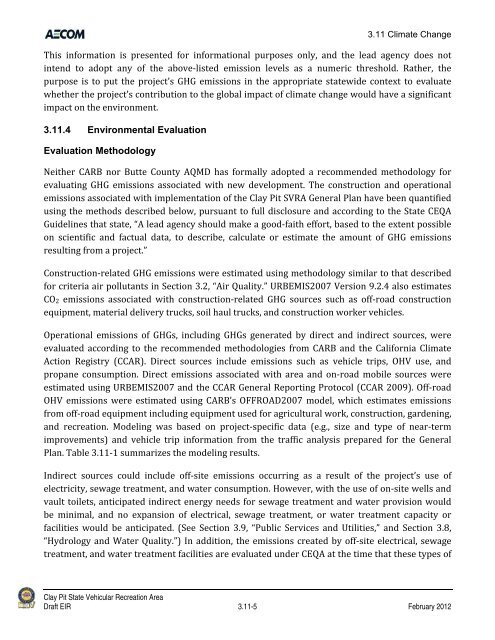Draft Environmental Impact Report - California Off Highway Vehicle ...
Draft Environmental Impact Report - California Off Highway Vehicle ...
Draft Environmental Impact Report - California Off Highway Vehicle ...
Create successful ePaper yourself
Turn your PDF publications into a flip-book with our unique Google optimized e-Paper software.
3.11 Climate Change<br />
This information is presented for informational purposes only, and the lead agency does not<br />
intend to adopt any of the above‐listed emission levels as a numeric threshold. Rather, the<br />
purpose is to put the project’s GHG emissions in the appropriate statewide context to evaluate<br />
whether the project’s contribution to the global impact of climate change would have a significant<br />
impact on the environment.<br />
3.11.4 <strong>Environmental</strong> Evaluation<br />
Evaluation Methodology<br />
Neither CARB nor Butte County AQMD has formally adopted a recommended methodology for<br />
evaluating GHG emissions associated with new development. The construction and operational<br />
emissions associated with implementation of the Clay Pit SVRA General Plan have been quantified<br />
using the methods described below, pursuant to full disclosure and according to the State CEQA<br />
Guidelines that state, “A lead agency should make a good‐faith effort, based to the extent possible<br />
on scientific and factual data, to describe, calculate or estimate the amount of GHG emissions<br />
resulting from a project.”<br />
Construction‐related GHG emissions were estimated using methodology similar to that described<br />
for criteria air pollutants in Section 3.2, “Air Quality.” URBEMIS2007 Version 9.2.4 also estimates<br />
CO2 emissions associated with construction‐related GHG sources such as off‐road construction<br />
equipment, material delivery trucks, soil haul trucks, and construction worker vehicles.<br />
Operational emissions of GHGs, including GHGs generated by direct and indirect sources, were<br />
evaluated according to the recommended methodologies from CARB and the <strong>California</strong> Climate<br />
Action Registry (CCAR). Direct sources include emissions such as vehicle trips, OHV use, and<br />
propane consumption. Direct emissions associated with area and on‐road mobile sources were<br />
estimated using URBEMIS2007 and the CCAR General <strong>Report</strong>ing Protocol (CCAR 2009). <strong>Off</strong>‐road<br />
OHV emissions were estimated using CARB’s OFFROAD2007 model, which estimates emissions<br />
from off‐road equipment including equipment used for agricultural work, construction, gardening,<br />
and recreation. Modeling was based on project‐specific data (e.g., size and type of near‐term<br />
improvements) and vehicle trip information from the traffic analysis prepared for the General<br />
Plan. Table 3.11‐1 summarizes the modeling results.<br />
Indirect sources could include off‐site emissions occurring as a result of the project’s use of<br />
electricity, sewage treatment, and water consumption. However, with the use of on‐site wells and<br />
vault toilets, anticipated indirect energy needs for sewage treatment and water provision would<br />
be minimal, and no expansion of electrical, sewage treatment, or water treatment capacity or<br />
facilities would be anticipated. (See Section 3.9, “Public Services and Utilities,” and Section 3.8,<br />
“Hydrology and Water Quality.”) In addition, the emissions created by off‐site electrical, sewage<br />
treatment, and water treatment facilities are evaluated under CEQA at the time that these types of<br />
Clay Pit State Vehicular Recreation Area<br />
<strong>Draft</strong> EIR 3.11-5 February 2012








